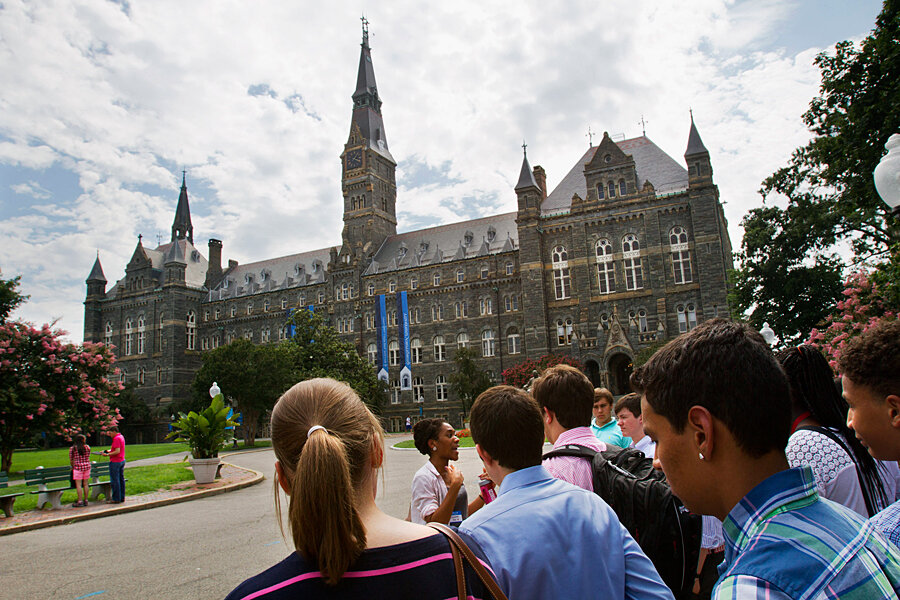College freshmen survey: Students cite cost in passing up first-choice school
Loading...
Cost and financial aid are driving students’ decisions about where to attend college more than ever.
Students are applying to more schools, and turning down their first-choice institution if it’s going to pose too much of a financial burden, according to the CIRP Freshman Survey, conducted annually by the Cooperative Institutional Research Program at the University of California, Los Angeles.
Showing everything from study habits to political views, the results of the survey – completed by more than 165,000 students – are weighted to represent all first-time, full-time undergraduates who started at four-year US colleges and universities in the fall of 2013.
For more than 40 years, students have consistently ranked the academic reputation of an institution as a key factor in choosing to attend. But over the past decade, financial concerns have begun to weigh almost as heavily.
Sixty-four percent say academic reputation was very important, and about 46 percent say cost of attendance was very important – the highest since the survey started asking the cost question 10 years ago. About 49 percent say the financial aid package was very important, the highest since the question was first asked 42 years ago.
Of the nearly 76 percent of students accepted to their first-choice school, just under 75 percent enrolled – the lowest ever. About 40 percent of those who didn’t go to their top choice say it was because they weren’t able to afford it.
Students are doing more comparison shopping, and in response, some colleges have begun in recent years to “package financial aid offers that include less reliance on loans,” says Kevin Eagan, CIRP’s interim director and co-author of the report.
But overall, financial aid from the federal government, states, and institutions is just not keeping up with needs, resulting in higher debt burdens, says Jessica Thompson, a senior policy analyst in the Washington office of the Institute for College Access & Success.
As a result, students are working longer hours (10 percent of freshmen say they work more than 20 hours a week), which can lead to higher dropout rates.
Efforts are under way to help more students understand the full cost of attending various colleges – including cost calculators required by the government that enable comparisons across similar institutions.
But more consumer education is still needed, Ms. Thompson says. Some students, because of financial concerns that may be misinformed, “opt for a school where their chances of completion are a lot lower,” she says.
The CIRP survey shows that 84 percent of freshmen believe they will graduate in four years, but research indicates fewer than half actually will, Thompson adds.
A new aspect of the CIRP survey this year is how students rate themselves on skills for diverse workplaces.
They generally see themselves as able to tolerate different beliefs and work cooperatively with others. But less than one-third said that openness to having their views challenged was a “major strength.”
Today’s students do “much better on racial issues than any generation we’ve seen.... However, the fact that they can’t tolerate criticism is also a reality,” says Arthur Levine, co-author of “Generation on a Tightrope” and president of the Woodrow Wilson National Fellowship Foundation in Princeton, N.J.
The degree to which students have grown up protected and continually praised by adults has led them to feel like criticism means they’ve failed, Mr. Levine says. “That’s not good for a generation that’s going to live in a time of profound change,” he says, and it means colleges need to reduce grade inflation and create opportunities for students to get critical feedback.
There's a great deal of discussion within colleges about how to adapt to "digital natives" who arrive already using online educational tools. Surprisingly, though, only about 9 percent of freshmen say there’s a very good chance they’ll enroll in an online course while in college.
That doesn’t mean they won’t use online resources, however. Nearly 42 percent of freshmen say they used an online instructional website (such as Khan Academy) assigned for a class occasionally or frequently in the previous year. Even more, 69 percent, used such sites on their own.
Those students who sought out online instruction on their own were more likely to show “habits of mind” associated with academic success and lifelong learning – such as seeking solutions to problems, asking for feedback on academic work, and exploring topics on their own. Forty-two percent who frequently used online instruction on their own scored high in the habits-of-mind scale, compared with 22 percent of those who only occasionally sought out online instruction.
As for freshmen’s views on some hot-button political issues:
- 83 percent support the right of gay couples to adopt, up from nearly 77 percent in 2010.
- 68 percent endorse the idea that wealthier people should pay a greater share of taxes than they currently pay.
- 64 percent believe the federal government should do more to control handgun sales, down from a peak of 84 percent in 1998.






